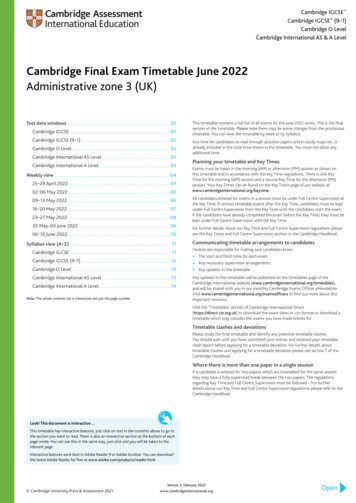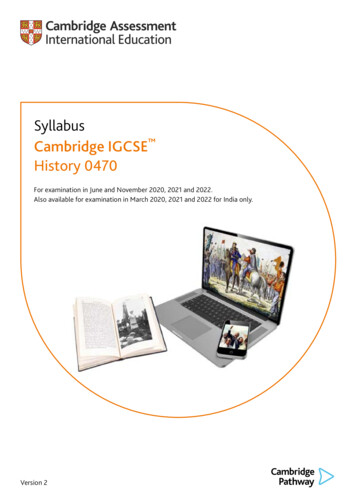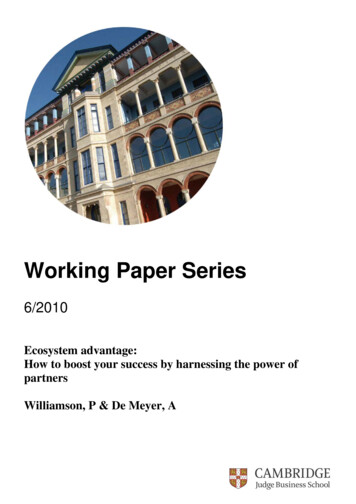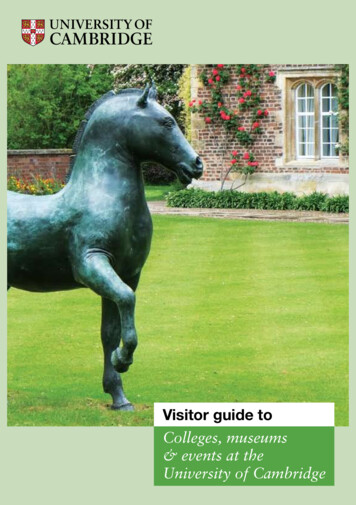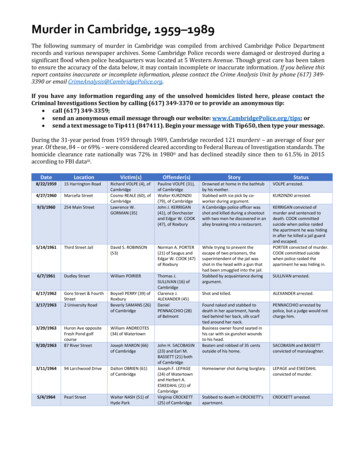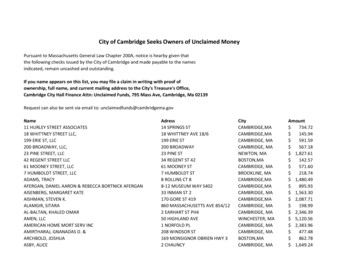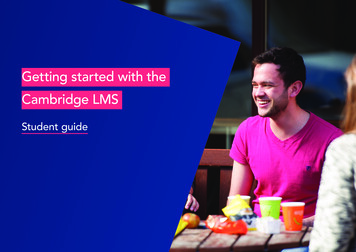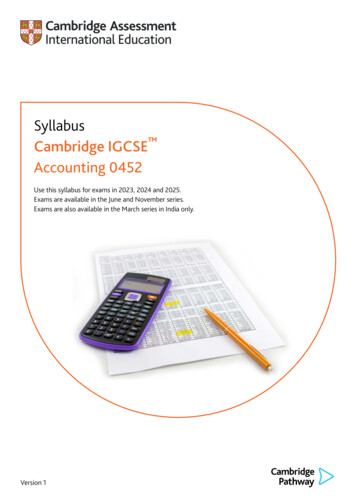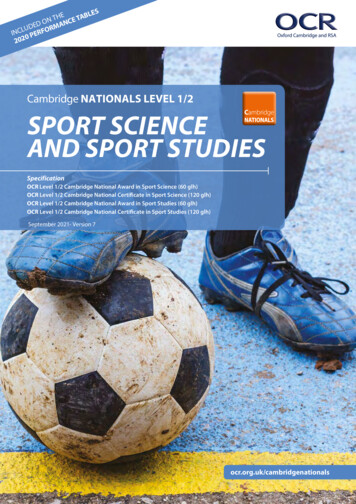
Transcription
SEBLEHATTNCEED O RMANDULINC PERFO0202Cambridge NATIONALS LEVEL 1/2SPORT SCIENCEAND SPORT STUDIESSpecificationOCR Level 1/2 Cambridge National Award in Sport Science (60 glh)OCR Level 1/2 Cambridge National Certificate in Sport Science (120 glh)OCR Level 1/2 Cambridge National Award in Sport Studies (60 glh)OCR Level 1/2 Cambridge National Certificate in Sport Studies (120 glh)September 2021- Version 71ocr.org.uk/cambridgenationals
Summary of key changes to this specificationSectionChangeVersionand dateissued4.1 The centre-assessed units4.6 Moderation7.1 Availability of assessment7.2.2 Making final unit entriesAppendix AReference to Visiting Moderation removed.Version 7September20214.6.3 Moderated via visitingmoderationSection deleted1.5 Overview of thequalificationsDue to the withdrawal of the Awards (J802 &J803)) and the Certificates (J812 & J813), thefinal assessment opportunity for these havebeen clarified in the tables.7.1 Availability of assessmentVersion 6April 20214.5.3 Reporting suspectedmalpracticeNew section added5.4.2 OCR InterchangeUpdated information8.2 Progression from/to thesequalificationsDiagram and text updated to reflect currentprogression routes.3.4 Grading and awardinggradesAdditional text added to clarify the potential forgrade thresholds to change.Version 5December2019AllNew format for the specification, however withthe exception of the changes highlightedbelow, the content remains unchangedVersion 4September2019ThroughoutThe term ‘model assignment’ has beenreplaced with ‘set assignment’ throughout.2.9 Sport Studies Unit R052:Developing sports skillsA list of approved activities that learners will beassessed on has been added.2.13 Sport Studies Unit R056:Developing knowledge and skillsin outdoor activities3.2 Overview of the assessmentin the Cambridge Nationals inSport Studies4.5 AuthenticationUpdated information on the use of Centreauthentication forms.6.2 AccessibilityUpdated information on approval requirementsand permissible access arrangements.7 AdministrationUpdated information8.1 Progression from thesequalificationsUpdated information8 Other informationThe following information has been removed:Key SkillsFunctional Skills OCR 2021OCR Level 1/2 Cambridge National Award/Certificate in Sport Science and Sport studies1Version 7 (Sept 2021)
Section2.2 Sport Science Unit R041:Reducing the risk of sportsinjuriesChangeVersionand dateissuedAt the end of each unit added a sectionConnections between units for synopticassessmentVersion 3November2018Unit R042: Applying principlesof trainingUnit R043: The body’sresponse to physical activityUnit R044: Sport psychologyUnit R045: Sports nutritionUnit R046: Technology in sportUnit R051: Contemporaryissues in sportUnit R052: Developingsports skillsUnit R053: Sports leadershipUnit R054: Sport and the mediaUnit R055: Working in thesports industryUnit R056: Developingknowledge and skills in outdooractivitiesSynoptic assessment7.4 Unit and qualification resitsUpdated sectionUpdated information about resits for theexternally assessed unit. OCR 2021OCR Level 1/2 Cambridge National Award/Certificate in Sport Science and Sport studiesVersion 2September20182Version 7 (Sept 2021)
OCR Cambridge Nationals in SportQualification titleGuided LearningHours (GLH)EntryCodeReferenceOCR Level 1/2 Cambridge National Award inin Sport Science60J802600/5120/6OCR Level 1/2 Cambridge NationalCertificate in in Sport Science120J812600/5121/8OCR Level 1/2 Cambridge National Award inin Sport Studies60J803600/5122/XOCR Level 1/2 Cambridge NationalCertificate in in Sport Studies120J813600/5123/1Withdrawal of Level 1/2 Cambridge Nationals Awards and Certificates in Sport Science andSport Studies.Following the development of a new suite of Cambridge Nationals qualifications, which will beavailable to teach from September 2022, we are withdrawing the qualifications above. We will, ofcourse, continue to support and assess these qualifications up to the conclusion of the finalassessment series in June 2023.The final assessment opportunity for all units is the June 2023 series with a resit opportunity for theexamined units only in the January 2024 series.As the qualification is designed for delivery over a two-year period, the last opportunity for Year 10students to start a two-year programme is September 2021. OCR 2021OCR Level 1/2 Cambridge National Award/Certificate in Sport Science and Sport studies1Version 7 (Sept 2021)
ContentsSummary of key changes to this specification1OCR Cambridge Nationals in Sport115234Introduction1.1Qualification aims51.2Qualification summary61.3Qualification size (GLH and TQT)61.4Prior learning/attainment61.5Overview of the qualifications7Units92.1Guidance on unit content92.2Sport Science Unit R041: Reducing the risk of sports injuries102.3Sport Science Unit R042: Applying principles of training142.4Sport Science Unit R043: The body’s response to physical activity172.5Sport Science Unit R044: Sport psychology202.6Sport Science Unit R045: Sports nutrition232.7Sport Science Unit R046: Technology in sport262.8Sport Studies Unit R051: Contemporary issues in sport292.9Sport Studies Unit R052: Developing sports skills342.10Sport Studies Unit R053: Sports leadership362.11Sport Studies Unit R054: Sport and the media382.12Sport Studies Unit R055: Working in the sports industry422.13Sport Studies Unit R056: Developing knowledge and skills in outdoor activities45Assessment483.1Overview of the assessment in the Cambridge Nationals in Sport Science483.2Overview of the assessment in the Cambridge Nationals in Sport Studies503.3Synoptic assessment513.4Grading and awarding grades673.5Performance descriptions693.6Quality of written communication72The centre-assessed units (R042–R046 and R052–R056)734.1The centre-assessed units734.2Tasks for the centre-assessed units734.3Completing the tasks754.4Marking and moderating centre assessed units76 OCR 2021OCR Level 1/2 Cambridge National Award/Certificate in Sport Science and Sport studies2Version 7 (Sept 2021)
Free resources825.2Free teaching and Learning resources825.3Professional Development835.4OCR Support services83Access846.1Equality Act information relating to Cambridge Nationals in bility of assessment857.2Making entries857.3Certification rules877.4Unit and qualification resits877.5Post-results services887.6Shelf-life of units88Other information898.1Overlap with other qualifications898.2Progression from/to these qualifications898.3Avoidance of bias898.4Criteria requirements908.5Language908.6Spiritual, moral, ethical, social, legislative, economic and cultural issues908.7Sustainable development, health and safety consideration and European developmentswith international agreements91Appendix A: Guidance on witness statements92Appendix B: External assessment guidance93Appendix C: Marking criteria for centre assessment95Sport Science Unit R042: Applying principles of training95Sport Science Unit R043: The body’s response to physical activity99Sport Science Unit R044: Sport psychology106Sport Science Unit R045: Sports nutrition112Sport Science Unit R046: Technology in sport119Sport Studies Unit R052: Developing sports skills125Sport Studies Unit R053: Sports leadership129 OCR 2021OCR Level 1/2 Cambridge National Award/Certificate in Sport Science and Sport studies3Version 7 (Sept 2021)
Sport Studies Unit R054: Sport and the media135Sport Studies Unit R055: Working in the sports industry142Sport Studies Unit R056: Developing knowledge and skills in outdoor activities148Appendix D: Guidance for the production of electronic internal assessment154Appendix E: Marking criteria glossary of terms156 OCR 2021 This document can be reproduced for teaching purposes. Centres cannot reproduce OCR materials if thepurpose is to sell the materials (to learners or others). Permission to make this document available on an internet sitemust be obtained in writing from OCR's copyright Team at OCR (Oxford Cambridge and RSA Examinations), TheTriangle Building, Shaftesbury Road, Cambridge, CB2 8EA, Email: ocr.copyright@ocr.org.uk. For full details of OCR’scopyright policy please see our website. OCR 2021OCR Level 1/2 Cambridge National Award/Certificate in Sport Science and Sport studies4Version 7 (Sept 2021)
1Introduction1.1Qualification aimsSport is a key theme in most areas of both education and health policy. The need for people tolead healthy and active rather than sedentary lifestyles is increasingly prominent in respect ofgovernment initiatives, and this is reflected in the school curriculum, where physical education andsport remains core; these qualifications seek to build upon this provision at key stages 3 and 4.These sport qualifications offer learners the chance to develop different types of skills throughlargely practical means; communication, problem solving, team working, evaluation and analysis,performing under pressure, and formulating written findings from practical investigation are alltransferable skills which can be learned and assessed through these qualifications and utilised inmany other educational and employment settings.Both qualifications have been designed with practical and engaging ways of teaching in mind andenable learners to: develop a range of skills through involvement in sport and physical activity in differentcontexts and roles develop their ability to apply theoretical knowledge to practical situations gain a better understanding of the complexity of different areas of sport and the sportsindustry increase their awareness of different ways to stay involved in sport and physical activity andof different careers and roles within sport.Cambridge Nationals in Sport ScienceElite sport has embraced sport science disciplines wholeheartedly in the past few decades, movingfrom a perspective which assumed the primacy of natural talent in producing outstandingperformance, to one which considers every minute detail of an athlete’s training programme, resttime, environment and psychology in the pursuit of excellence. The Cambridge Nationals in SportScience offer learners the opportunity to study key areas of sport science including anatomy andphysiology linked to fitness, health, injury and performance; the science of training and applicationof training principles, and psychology in sport and sports performance.Cambridge Nationals in Sport StudiesThe Cambridge Nationals in Sport Studies take a more sector-based focus, whilst alsoencompassing some core sport/physical education themes. Learners have the opportunity to applytheoretical knowledge about different types of sport and physical activity, skills development andsports leadership to their own practical performance. They will learn about contemporary issues insport such as funding, participation, ethics and role models, and sport and the media. Learners willdevelop an appreciation of the importance of sport locally and nationally, different ways of beinginvolved in sport and of how this shapes the sports industry.This specification contains OCR’s Cambridge National Award/Certificate in Sport Science andCambridge National Award/Certificate in Sport Studies. OCR 2021OCR Level 1/2 Cambridge National Award/Certificate in Sport Science and Sport studies5Version 7 (Sept 2021)
1.2Qualification summaryThe Cambridge Nationals in Sport qualifications consist of:The OCR Level 1/2 Cambridge National Award in Sport Science consists of two mandatory units.The OCR Level 1/2 Cambridge National Award in Sport Studies consists of two mandatory units.The OCR Level 1/2 Cambridge National Certificate in Sport Science consists of two mandatoryunits and two optional units.The OCR Level 1/2 Cambridge National Certificate in Sport Studies consists of two mandatoryunits and two optional units.1.3Qualification size (GLH and TQT)The size of the qualification is described in terms of Guided Learning Hours (GLH) and TotalQualification Time (TQT).GLH indicates the approximate time (in hours) the teacher will spend supervising or directing studytime and assessment activities. We have worked with people who are experienced in deliveringrelated qualifications to determine what content needs to be taught and how long it will take todeliver.TQT is comprised of two elements: GLH, and an estimate of the number of hours a learner willreasonably spend on any unsupervised learning or assessment activities (including homework) sothey can successfully achieve their qualification.OCR Level 1/2 Cambridge National Award in Sport Science is 60 GLH and the TQT is 83.OCR Level 1/2 Cambridge National Certificate in Sport Science is 120 GLH and the TQT is 161.OCR Level 1/2 Cambridge National Award in Sport Studies is 60 GLH and the TQT is 79.OCR Level 1/2 Cambridge National Certificate in Sport Studies is 120 GLH and the TQT is 162.1.4Prior learning/attainmentLearners who are taking courses leading to any of these qualifications should normally have acorresponding Key Stage 3 Programme of Study within the National Curriculum. OCR 2021OCR Level 1/2 Cambridge National Award/Certificate in Sport Science and Sport studies6Version 7 (Sept 2021)
1.5Overview of the qualificationsSport Science UnitsAssessment methodGLHJ802Award60 GLHJ812Certificate120GLHMandatoryR041: Reducing therisk of sports injuriesWritten paperOCR set and marked1 hour – 60 marks (60 UMS)Learners answer all questions30M M R042: Applyingprinciples of trainingCentre-assessed tasksOCR-moderated60 marks (60 UMS)Learners should spend approximately10 hours on the assessment tasks30M*M*OptionalR043: The body’sresponse to physicalactivityCentre-assessed tasksOCR-moderated60 marks (60 UMS)Learners should spend approximately10 hours on the assessment tasks30n/aO*R044: SportpsychologyCentre-assessed tasksOCR-moderated60 marks (60 UMS)Learners should spend approximately10 hours on the assessment tasks30n/aO*Centre-assessed tasksOCR-moderated60 marks (60 UMS)Learners should spend approximately10 hours on the assessment tasks30n/aO*Centre-assessed tasksOCR-moderated60 marks (60 UMS)Learners should spend approximately10 hours on the assessment tasks30n/aO*R045: SportsnutritionR046: Technology insportKey:M mandatory unitO optional unitA bank of set assignments is available free of charge from the OCR website for the internallyassessed units R042–R046.*June 2023 series is the final moderation opportunity for OCR Cambridge National Award andCertificate in Sport Science Units R042 – R046. January 2024 is the final resit opportunity for Unit R041. OCR 2021OCR Level 1/2 Cambridge National Award/Certificate in Sport Science and Sport studies7Version 7 (Sept 2021)
Sport Studies UnitsAssessment methodGLHJ803Award60 GLHJ813Certificate120GLHMandatoryR051: Contemporaryissues in sportWritten paperOCR set and marked1 hour – 60 marks (60 UMS)Learners answer all questions30M M R052: Developingsports skillsCentre-assessed tasksOCR-moderated60 marks (60 UMS)Learners should spend approximately10 hours on the assessment tasks30M*M*Centre-assessed tasksOCR-moderated60 marks (60 UMS)Learners should spend approximately10 hours on the assessment tasks30n/aO*Centre-assessed tasksOCR-moderated60 marks (60 UMS)Learners should spend approximately10 hours on the assessment tasks30n/aO*Centre-assessed tasksOCR-moderated60 marks (60 UMS)Learners should spend approximately10 hours on the assessment tasks30n/aO*Centre-assessed tasksOCR-moderated60 marks (60 UMS)Learners should spend approximately10 hours on the assessment tasks30n/aO*OptionalR053: SportsleadershipR054: Sport and themediaR055: Working in thesports industryR056: Developingknowledge and skillsin outdoor activitiesKey:M mandatory unitO optional unitA bank of set assignments is available free of charge from the OCR website for the internallyassessed units R052–R056.*June 2023 series is the final moderation opportunity for OCR Cambridge National Award andCertificate in Sport Studies Units R052 – R056. January 2024 is the final resit opportunity for Unit R051. OCR 2021OCR Level 1/2 Cambridge National Award/Certificate in Sport Science and Sport studies8Version 7 (Sept 2021)
2Units2.1Guidance on unit contentUse of i.e./e.g. in unit contentThe unit content describes what has to be taught to ensure that learners are able to accessthe highest marks.Anything which follows an i.e. details what must be taught as part of that area of content.Anything which follows an e.g. is illustrative, it should be noted that where e.g. is used, learnersmust know and be able to apply relevant examples in their work, though these do not need to bethe same ones provided in the unit content.Teachers will need to ensure that any modifications to tasks, from the bank of set assignmentsfor the optional units, do not expect the learner to do more than they have been taught, but theymust enable them to access the full range of marks as described in the marking criteria.For externally assessed units, where the content contains i.e. and e.g. under specific areas ofcontent, the following rules will be adhered to when setting questions: direct question may be asked where the unit content is shown with an i.e. where unit content is shown as an e.g., a direct question will not be asked about thatexample. Any questions relating to the area of content will offer learners the opportunity toprovide their own examples, as the unit has not specified which examples they should befamiliar with. OCR 2021OCR Level 1/2 Cambridge National Award/Certificate in Sport Science and Sport studies9Version 7 (Sept 2021)
2.2Sport Science Unit R041: Reducing the risk of sports injuriesAimsTaking part in sport and physical activity puts the body under stress. Knowing how to reduce therisk of injury when taking part in sport, and how to respond to injuries and medical conditions in asport setting are, therefore, vital skills in many roles within the sport and leisure industry, whetheryou are a lifeguard, a steward at a sports stadium or a personal fitness instructor.By completing this unit, learners will know how to prepare participants to take part in physicalactivity in a way which minimises the risk of injuries occurring, how to react to common injuries thatcan occur during sport and how to recognise the symptoms of some common medical conditions,providing a good foundation to undertake formal first aid training and qualifications.Learning Outcome 1: Understand different factors which influence the risk of injuryLearners must be taught: extrinsic factors which can influence the risk of injury, i.e.o type of activity (e.g. contact sports present different injury risks from gymnastic activities)o coaching/supervision, i.e.- poor/incorrect coaching techniques- ineffective communication skills- importance of adhering to rules and regulationso environmental factors, i.e.- weather- playing surface/performance area and surrounding area- other participantso equipment, i.e.- protective equipment (e.g. shin pads in football, gum shield in boxing, helmet in cycling,goggles in skiing)- performance equipment (e.g. hockey stick, cricket ball, rock climbing harness)- clothing/footwear suitable for playing surface/weather conditions/specific sport oractivityo safety hazards, i.e.- risk assessments- safety checks- emergency action plans intrinsic factors which can influence the risk of injury, i.e.o physical preparation, i.e.- training- warm up- cool down- fitness levels- overuse- muscle imbalanceso individual variables, i.e.- gender- age- flexibility OCR 2021OCR Level 1/2 Cambridge National Award/Certificate in Sport Science and Sport studies10Version 7 (Sept 2021)
- nutrition- sleep- previous/recurring injurieso psychological factors, i.e.- motivation- aggression- arousal/anxiety levelso posture and causes of poor posture, i.e.- poor stance/gait (e.g. bending your knees or hunching your shoulders when standing)- sitting positions (e.g. slumping/slouching on the sofa rather than sitting upright)- physical defects (e.g. muscles weaken around an injured area)- lack of exercise (e.g. lack of core muscle strength means less support, beingoverweight puts strain on posture)- fatigue (e.g. tired muscles will be unable to support the skeleton properly)- emotional factors (e.g. having low self-esteem/lack of confidence can influence posture)- clothing/footwear (e.g. wearing shoes with high heels can affect posture)o sports injuries related to poor posture, i.e.- pelvic tilt- lordosis- kyphosis- round shoulder- scoliosis.Learning Outcome 2: Understand how appropriate warm up and cool down routines canhelp to prevent injuryLearners must be taught: the physical benefits of a warm up, i.e.o warming up muscles/preparing the body for physical activityo increase in body temperatureo increase in heart rateo increase in flexibility of muscles and jointso increase in pliability of ligaments and tendonso increase in blood flow and oxygen to muscleso increase in the speed of muscle contraction the psychological benefits of a warm up, i.e.o heighten or control arousal levels (e.g. ‘get in the zone’ or settle nerves)o improve concentration/focuso increase motivationo mental rehearsal key components of a warm up, i.e.o pulse raising, i.e. exercises that slowly increase heart rate and body temperature (e.g.jogging, cycling, skipping)o mobility, i.e. exercises that take the joints through their full range of movement (ROM) (e.g.arm swings, hip circles)o dynamic movements (e.g. change of speed and direction)o stretching (e.g. developmental stretches, dynamic stretches linked to sport – ‘open andclose the gate’ groin walk)o skill rehearsal phase, i.e. rehearsing common movement patterns and skills which will beused in the activity (e.g. dribbling drills for football, passing drills for netball) OCR 2021OCR Level 1/2 Cambridge National Award/Certificate in Sport Science and Sport studies11Version 7 (Sept 2021)
physical benefits of a cool down, i.e.o helps the body’s transition back to a resting stateo gradually lowers heart rateo gradually lowers temperatureo circulates blood and oxygeno reduces breathing rateo removes waste products such as lactic acido reduces the risk of muscle soreness and stiffnesso aids recovery by stretching muscles, i.e. lengthening and strengthening muscles for nextwork-out/use key components of a cool down, i.e.o pulse lowering, i.e. exercises which gradually lower heart rate and reduce temperature(e.g. easy movements, light running, stretching)o stretching, i.e. maintenance stretches, static stretches (e.g. hamstring stretches) specific needs which a warm up and cool down must consider, i.e.o characteristics of the individual/group, i.e.- size of group- age of participants- experience of participants- individual fitness levels- any medical conditions participants may haveo suitability as preparation for a particular activity/sporto environmental factors (e.g. weather/temperature if outdoors, available facilities).Learning Outcome 3: Know how to respond to injuries within a sporting contextLearners must be taught about: acute and chronic injurieso acute injuries, i.e.- caused as a result of a sudden trauma to the body (e.g. hard rugby tackle, being hit bya ball)- result in immediate pain, and usually swelling with a loss of functiono chronic injuries, i.e.- also known as overuse injuries and are a result of continuous stress on an area (e.g.Achilles tendonitis, shin splints or tennis elbow)- these injuries tend to develop gradually over a period of time types, causes and treatment of common sports injuries, i.e.o soft tissue injuries, i.e. sprains, strainso overuse injuries, i.e. tendonitis, tennis elbow, golfers elbow, shin splintso fractures, i.e. open, closedo concussion, i.e. signs and symptoms of concussiono abrasions, i.e. grazes and cutso contusions, i.e. bruiseso blisters (e.g. blisters on the foot due to poorly fitting footwear)o cramp, i.e. painful sensations caused by muscle contractions or over shorteningo injuries related to children (e.g. severs diseases, Osgood Schlatter’s disease) how to respond to injuries and medical conditions in a sporting context, i.e.o SALTAPS on-field assessment routine (See, Ask, Look, Touch, Active, Passive, Strength)o R.I.C.E. (Rest, Ice, Compress, Elevate) OCR 2021OCR Level 1/2 Cambridge National Award/Certificate in Sport Science and Sport studies12Version 7 (Sept 2021)
stretching and massagetaping, bandaging, splints, slingshot and cold treatments (e.g. heat pack, freeze spray)action plan to respond to injuries and medical conditions in a sporting context i.e.emergency procedures Emergency Action Plans (EAP) in a sporting context:o emergency personnel, i.e. first responder, first aider, coacho emergency communication, i.e. telephone, emergency numbers, emergency serviceso emergency equipment, i.e. first aid kits, evacuation chair.ooooLearning Outcome 4: Know how to respond to common medical conditionsLearners must be taught: the symptoms of common medical conditions, i.e.o Asthma, i.e. coughing, wheezing, shortness of breath, tightness in the chest.o Diabetes, i.e. increased thirst, going to the toilet lots, extreme tiredness, and weight loss,differences between Type 1 (insulin-dependent) and Type 2 (non-insulin dependent)o Epilepsy, i.e. seizures how to respond to these common medical conditions, i.e.o ensure awareness of any participants’ medical conditions prior to commencing physicalactivityo Asthma, i.e. reassurance, inhaler, emergency services (if needed)o Diabetes, i.e. insulin (or glucose) hypoglycaemia (low blood sugar), give the individualsugar (e.g. fruit juice, sugary sweets)o Epilepsy, i.e. emergency care plans in place for the individualo when to refer the performer on to a professional and how to do so.During the external assessment, learners will be expected to demonstrate their understandingthrough questions that require the skills of analysis and evaluation in particular contexts.Connections between units for synoptic assessmentIt is strongly recommended that learners complete the learning for this unit (R041) beforecompleting assessment of other units within this qualification, as teaching of this unit will developkey knowledge, skills and understanding which should be applied and assessed in context furtherthroughout the qualification.Further information regarding synoptic assessment within this qualification can be found undersection 3.3 Synoptic Assessment. OCR 2021OCR Level 1/2 Cambridge National Award/Certificate in Sport Science and Sport studies13Version 7 (Sept 2021)
2.3Sport Science Unit R042: Applying principles of trainingAimsIn the world of team and individual sport, it is vital that coaches keep their performers in peakcondition. They do this by regularly monitoring them through fitness tests and by designingbespoke training programmes to suit the type of sport, performance schedule and the individualthemselves. High quality training programmes apply principles of training to the requirements of theindividual in their development and implementation.By completing this unit, learners will develop knowledge and understanding of the principles andmethods of training and the application of these in the design of training programmes along withpractical skills in fitness testing.Learning Outcome 1: Know the principles of training in a sporting contextLearners must be taught: the principles of training in a sporting context, i.e.o progression, i.e. progressive overload by increasing frequency, intensity, time, type,adherence (FITTA) (e.g. more repetitions from one session to another)o specificity, i.e. practices a skill used in a sport, trains the muscle group(s) predominantlyused in a sport (e.g. passing the ball in rugby)o reversibility/regression, i.e. ‘use it or lose it’ (e.g. where injury may affect performance)o moderation, i.e. taking into account age, gender, environment and experience (e.g. asession which will include young athletes and mature performers)o variance, i.e. avoiding boredom, gives the body a different challenge, mixture of fitnessand skill.Learning Outcome 2: Know how training methods target different fitness componentsLearners must be taught: aerobic and anaerobic exercise, i.e.o difference between aerobic and anaerobic exercise, i.e.- aerobic, i.e. utilising oxygen to fuel the body during exercise- anaerobic, i.e. fuelling the body during exercise without using oxygeno methods of training aerobically and anaerobically, i.e.- aerobic, i.e. steady and not too fast (e.g. walking, jogging, cycling)- anaerobic, i.e. performed in short, fast bursts (e.g. weight lifting, interval training) the components of fitness, i.e.o strength, i.e. the extent to which a muscle or muscle groups can contract againstresistance (e.g. restraining an opponent in rugby)o power, i.e. exerting muscular strength rapidly (e.g. sprint start)o agility, i.e. move quickly and change direction under control (e.g. weaving between objectsor opponents in a zig-zag motion)o balance, i.e. the ability to maintain a position (e.g. handstand)o flexibility, i.e. the ability to move joints through an ample range of motion (e.g. performingthe splits in gymnastics)o muscular endurance, i.e. the ability of a muscle to sustain repeated contractions (e.g.cycling)o cardiovascular endurance, i.e. the heart and lungs getting blood and oxygen to musclesand them using it (e.g. long distance running) OCR 2021OCR Level 1/2 Cambridge National Award/Certificate in Sport Science and Sport studies14Version 7 (Sept 2021)
specific training methods for each of the fitness components, i.e.o cardiovascular training (e.g. steady state (continuous), interval training, fartlek training)o resistance training (e.g. resistance machines, free weights, circuits)o power training (e.g. interval training, plyometrics, repetition and acceleration sprint training)o flexibility trainin
The body's response to physical activity. 17 2.5 Sport Science Unit R044: Sport psychology. 20 2.6 Sport Science Unit R045: Sports nutrition. 23 2.7 Sport Science Unit R046: Technology in sport. 26 2.8 Sport Studies Unit R051: Contemporary issues in sport. 29 2.9 Sport Studies Unit R052: Developing sports skills. 34


